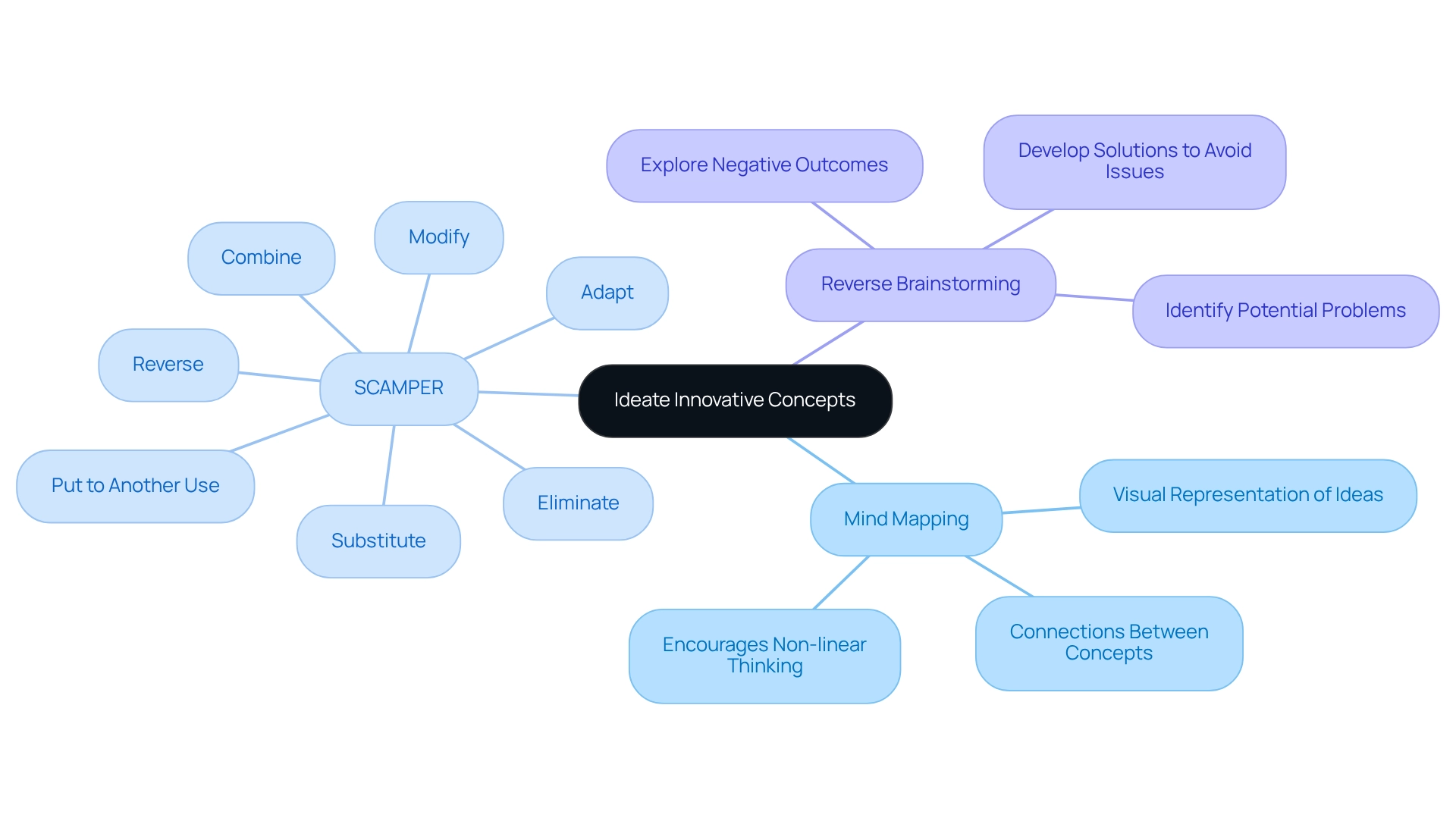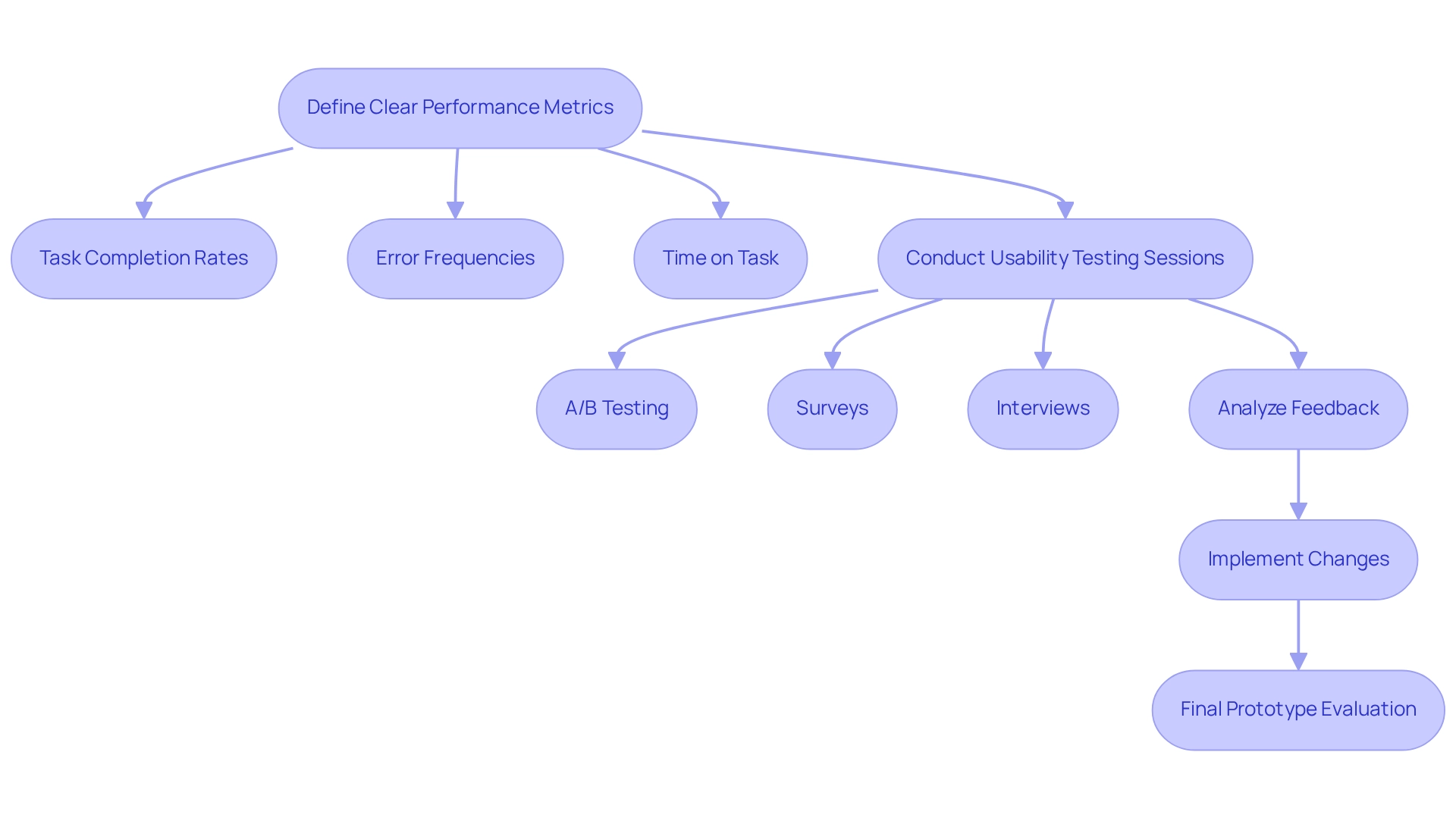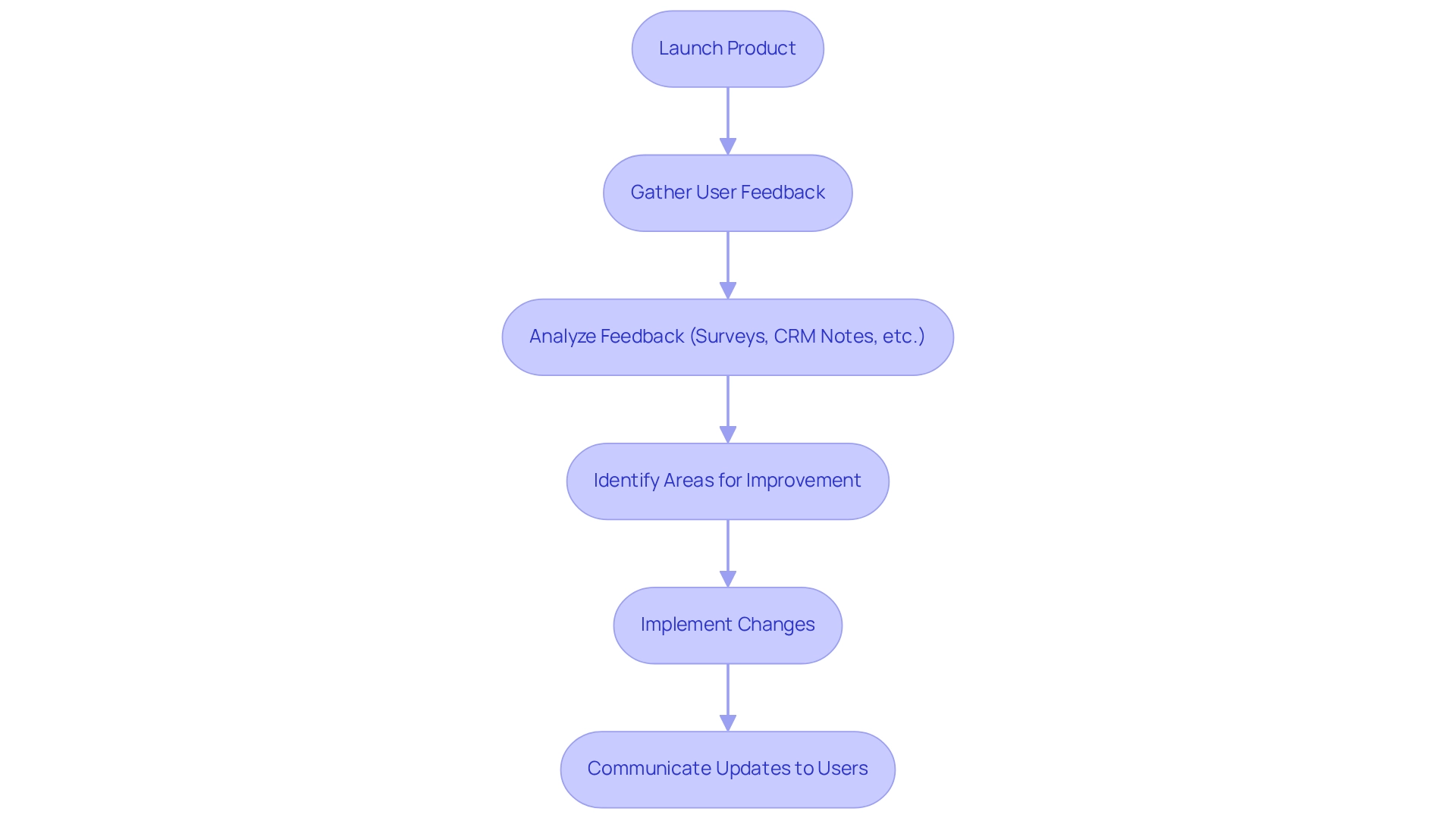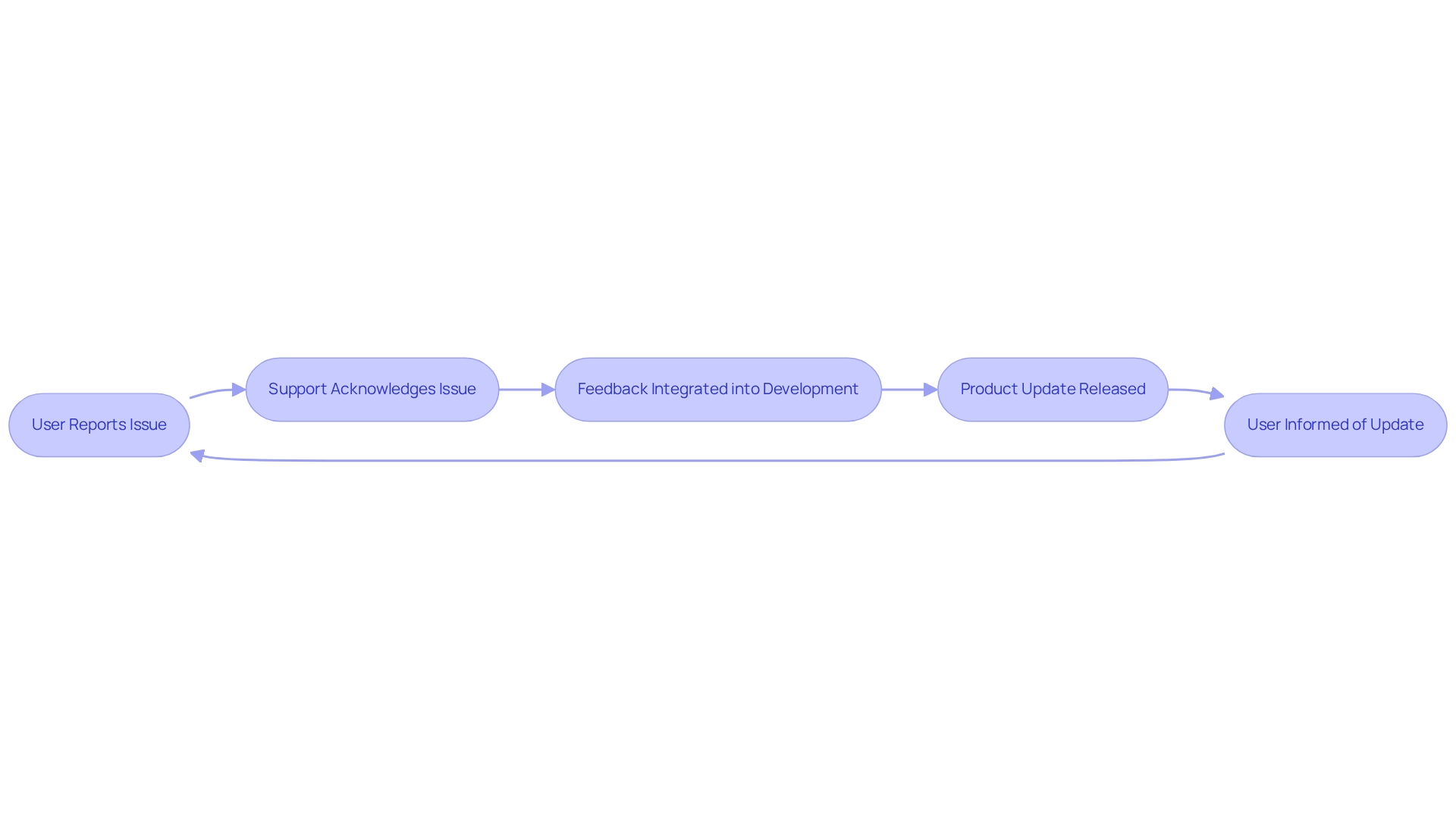Overview
For many startups, navigating the product development phase can feel overwhelming. The challenge often lies in ensuring that every step—from conducting thorough market research to launching effectively—aligns with both market needs and business objectives. When these essential steps are overlooked, the pain of misalignment can lead to wasted resources and missed opportunities.
Imagine pouring time and effort into a product that doesn't resonate with your target audience. It’s a common struggle that many founders face, and it can be disheartening. However, by focusing on vital processes such as:
- Ideating innovative concepts
- Developing prototypes
- Testing with target users
you can significantly enhance your chances of success. Each step is an opportunity to learn and adapt, ensuring that your product truly meets the needs of the market.
At RNO1, we understand the intricacies of this journey. We believe that providing continuous support and aligning product development with your business strategy is crucial. By gathering feedback and creating a thoughtful marketing strategy, you can launch your product with confidence, knowing that you’ve taken the necessary steps to connect with your audience. Remember, you’re not alone in this process; we’re here to support you every step of the way.
Introduction
In the ever-changing world of tech startups, the path from concept to launch can feel overwhelming, filled with both challenges and opportunities. Many founders grapple with the weight of innovation and the desire to capture market share, making a well-structured approach to product development not just beneficial, but essential.
This article explores the vital stages of launching a successful product, starting from the crucial step of conducting thorough market research to the importance of gathering user feedback after launch. By embracing innovative brainstorming techniques, creating prototypes, and testing concepts with target users, startups can refine their ideas and ensure they resonate with market demands.
Moreover, the significance of engineering feasibility, crafting effective marketing strategies, and providing ongoing support is paramount. With insights from industry experts and real-world case studies, this guide offers a compassionate roadmap for startups looking to navigate the complexities of product development and achieve enduring success in a competitive landscape.
Conduct Market Research
Begin by clearly outlining your research goals, as this lays the foundation for a meaningful exploration of the industry. It's essential to utilize both primary and secondary research techniques to gather comprehensive information about your target audience, competitors, and current industry trends. Primary research tools like surveys, focus groups, and interviews are invaluable for gaining firsthand insights, while secondary research offers the opportunity to analyze existing data and industry reports. For example, with over 1.13 billion websites globally, recognizing that only 18% are active underscores the competitive landscape that tech startups must navigate.
In 2025, the importance of industry research cannot be overstated; it is vital for startups eager to innovate and grow effectively. Current trends reveal a shift towards more tailored research strategies that address the unique challenges faced by B2B audiences. Chris Wells, and strategist, emphasizes:
- "We suggest that you create the research with a B2B audience in mind; take additional measures to enhance B2B respondent quality; customize your primary research approach for various sectors."
This approach necessitates crafting research that not only improves respondent quality but also aligns with specific industry needs.
Key considerations include the necessity of systematic data capture and clearly defined parameters, which can significantly enhance the effectiveness of both primary and secondary research. By adhering to best practices in secondary research, as illustrated in various case studies, startups can make more informed decisions that bolster their product development strategies.
Moreover, staying attuned to research trends in 2025, such as the increasing reliance on digital analytics and AI-driven insights, will empower startups to adapt swiftly to changing consumer behaviors. Monitoring various risks within the industry is also crucial for effective analysis and risk management. Case studies showcasing effective research techniques reveal that startups leveraging these insights can better align their offerings to meet industry needs, ultimately fostering growth and customer engagement. Expert opinions affirm that a robust research strategy is not merely advantageous but essential for navigating the complexities of today’s tech landscape.
Ideate Innovative Concepts
Generating a wealth of ideas can often feel overwhelming for many teams. The pressure to innovate and stay ahead in the market can create stress and uncertainty. To alleviate this, consider engaging in with your team. Techniques like:
- Mind mapping
- SCAMPER
- Reverse brainstorming
can serve as nurturing tools to stimulate creativity. By promoting open discussions and fostering teamwork, you can transform these ideas into feasible concepts that resonate with your market research findings. Remember, you’re not alone in this journey; sharing experiences and collaborating can lead to remarkable breakthroughs.

Develop Prototypes for Testing
Embarking on your development journey can feel daunting, especially when it comes to visualizing your ideas. Starting with low-fidelity prototypes, such as sketches or wireframes, is a gentle way to bring your concepts to life. Tools like Figma or Sketch can make this process smoother, helping you create digital prototypes that resonate with your vision. Once you have a basic prototype, take the time to refine it into a more sophisticated version for testing with real users. This iterative approach is crucial; it allows you to make adjustments based on valuable feedback, ensuring that your final product aligns with your expectations.
Research indicates that can enhance product success rates by as much as 70%. Physical items play a vital role in gathering insightful feedback. It's essential to keep the end-user at the forefront of your design process, as this focus can lead to impactful results. Notably, case studies like 'Common Mistakes in Rapid Prototyping and Design Thinking' highlight the importance of recognizing and avoiding common pitfalls in the prototyping process. By doing so, you can significantly improve the effectiveness of your design initiatives, ultimately leading to better experiences for your users. Additionally, the case study 'Differentiation Through Good Design' underscores that in competitive markets, effective design is key to standing out, emphasizing the need for tailored experiences that address specific pain points.
Looking ahead to 2025, the role of low-fidelity prototypes remains crucial, especially for startups. They provide a cost-effective way to explore ideas and validate concepts before diving into more extensive development. By following structured processes to create these prototypes, you can navigate the complexities of development with greater confidence and clarity. As David Hoang, Director of Design at Webflow, beautifully puts it, "This is truly like a golden age of design tools and prototyping tools that when I got started with never imagined the possibilities of it." Embrace this journey, knowing that you are not alone in facing these challenges.
Test Concepts with Target Users
Participating in usability testing sessions with your target audience is essential for understanding their interactions with your prototype. It can be disheartening to realize that a product may not meet users' needs, but employing a variety of methods—such as A/B testing, surveys, and interviews—can provide valuable insights. A/B testing, in particular, allows you to compare different versions of your offering to discover which one resonates more effectively with users, giving you crucial information about their preferences and behaviors. Many successful A/B testing cases have shown significant improvements in user engagement and satisfaction. For instance, the case study titled "The Value of Prototype Usability Testing" illustrates how prioritizing usability testing can accelerate development and reduce costs over time, leading to a more successful launch.
To enhance the effectiveness of your usability testing, it’s important to define clear performance metrics like:
- Task completion rates
- Error frequencies
- Time on task
These metrics are vital for assessing the success of your prototypes and pinpointing areas that need improvement. using high-fidelity prototypes can effectively assess flow and visual effectiveness before finalizing designs or moving into development milestones. High-fidelity prototypes are particularly beneficial as they provide a more accurate representation of the final product, allowing for better feedback on user interactions.
Incorporating expert insights, usability testing at the prototype stage is crucial for identifying potential issues, such as confusing navigation or poor information architecture, before significant resources are invested in development. As the Dovetail Editorial Team wisely noted, "Testing at the prototype stage helps catch problems like confusing navigation or poor information architecture, which can be corrected before significant resources are spent on development." By carefully analyzing the feedback gathered from these sessions, you can make informed decisions about necessary changes and improvements, ultimately leading to a more successful launch. Remember, you are not alone in this journey, and taking the time to understand your users' needs will pave the way for a brighter future.

Engineer for Performance and Feasibility
Collaboration between designers and engineers is a crucial aspect of evaluating the technical feasibility of your creation. This process entails a comprehensive assessment of materials, production methods, and associated costs. When your design aligns with engineering capabilities, you can enhance both performance and scalability. This collaborative approach is essential for a successful transition from prototype to production, as it enables the early identification of potential challenges in the development process.
In 2025, the importance of engineering feasibility evaluations has become even more pronounced. Data reveals that startups engaged in these assessments are significantly more likely to achieve successful launches. For example, case studies from RNO1 illustrate how effective collaboration can yield innovative solutions that not only satisfy market demands but also improve user experience. Their partnership with Figure to revolutionize compensation management through human-centered design exemplifies how startups that leverage advanced technologies can achieve remarkable improvements in customer engagement and satisfaction.
Furthermore, engineers stress the significance of enhancing performance through iterative design modifications. As Chris Ashby insightfully notes, "We require data and statistics that demonstrate its worth," highlighting the necessity of data-driven decision-making in development. Understanding the financial implications of design changes is equally important; startups must navigate the delicate balance between innovation and budget constraints to foster sustainable growth. By cultivating a strong alliance between , as showcased in RNO1's pioneering collaborations, startups can navigate the complexities of development more effectively, leading to successful outcomes in a competitive landscape.
Create a Marketing Strategy
Introducing a new item can often feel overwhelming for tech startup founders. The challenge lies in creating a comprehensive marketing plan that not only identifies your target audience but also articulates key messaging and promotional channels effectively. It’s important to understand the demographics and interests of your potential customers, as this knowledge allows you to tailor your approach in a way that resonates with them. By leveraging —such as social media, content marketing, and email campaigns—you can generate excitement and awareness around your product.
In 2025, many startups have found influencer marketing to be particularly effective. Studies reveal that 70% of millennials are swayed by the recommendations of their peers when making purchasing decisions. This not only enhances credibility but also expands your reach through trusted voices in your industry. Collaborating with influencers, much like RNO1's Ryde initiative, can amplify your message and help cultivate authentic relationships with your audience, especially when community involvement and omnichannel approaches are prioritized.
Additionally, forming strategic partnerships that align with your brand values can open doors to new customer segments and enhance your marketing efforts. As Craig Davis wisely notes, brands should focus on aligning their strategies with consumer interests rather than disrupting them. This shift can lead to improved engagement and loyalty, particularly when high-quality content is at the forefront of your campaigns. Moreover, as Stephen Covey emphasizes, network marketing has evolved into a pathway to entrepreneurship for many individuals, highlighting the importance of building connections in your marketing strategy.
By weaving these elements into your marketing approach, and reflecting on Jef Richards' insight—'Creativity without strategy is called art; creativity with strategy is called advertising'—you can create a robust framework that not only promotes your offering effectively but also nurtures lasting connections with your audience. Insights from RNO1's performance marketing expertise further illustrate that focusing on community building and genuine interactions is vital for tech startups in their marketing endeavors. Remember, you’re not alone on this journey; many have walked the same path and found success through thoughtful marketing strategies.
Launch the Product Effectively
Meticulous planning is essential in the product development phase for a successful market introduction. Many founders feel overwhelmed by the pressure of setting a definitive launch date and ensuring that all marketing materials are prepared well in advance. It can be daunting, but utilizing countdowns and teaser campaigns can help generate excitement and anticipation among your audience. Connecting with prospective clients through live events, webinars, or social media interactions not only cultivates a sense of community but also promotes early adoption of your offering.
In 2025, successful launch strategies emphasize the creation of buzz through shareable content tailored to your target audience. It’s important to recognize that brands harnessing the power of social media can significantly enhance their visibility. Memes, brief teasers, and viral videos can create a connection that resonates deeply. For instance, a recent study discovered that 70% of successful launches utilized social media to generate anticipation, resulting in a 50% rise in engagement rates. Partnering with influencers and promoting user-generated content can further enhance authenticity and reach, ultimately boosting engagement and visibility.
Moreover, launch events play a pivotal role in adoption rates. By fostering an inclusive environment that encourages interaction, brands can ensure that their offering resonates with a global audience. It’s essential to remember that continuous engagement post-launch is vital to maintain relevance and foster loyalty; studies show that brands engaging with their audience after launch see a 30% higher retention rate.
Optimal approaches for organizing a launch event include:
- Strategic timing
- Clear messaging
- Authentic interaction with customers
Reflecting on the case study "Generating Hype for Product Launches," we see how successfully created excitement through strategic planning and customer interaction. By following these principles during the product development phase, tech startups can generate lasting enthusiasm around their product launches, ensuring they become widely talked about and effectively adopted in the market. Remember, you’re not alone in this journey; with the right strategies, you can create a launch that truly resonates.
Gather Feedback and Improve
After launching a product, many founders face the challenge of gathering meaningful feedback from their users. This feedback is essential for identifying recurring issues and areas that need improvement. By actively seeking input through surveys, reviews, and direct communication, you can uncover valuable insights that inform strategies to enhance engagement and satisfaction. For instance, analyzing notes from can reveal deeper insights into client experiences and preferences, leading to significant improvements in customer interactions.
Making adjustments based on this feedback not only enhances your offering but also fosters a sense of community among your users. When you communicate updates and improvements, it shows your commitment to continuous enhancement—a crucial aspect in today’s fast-paced market. It’s noteworthy that effective user feedback collection techniques can lead to a 90% increase in the effectiveness of processes like customer refund management, highlighting the tangible benefits of a robust feedback loop during product development.
Many effective approaches for product enhancement stem from user feedback gathered during the development phase. Case studies illustrate how companies have successfully adapted their products based on insights gained after launch. For example, reviewing CRM notes has helped businesses discover valuable information that shapes their strategies for improving customer engagement and satisfaction. Product managers stress that continuous enhancement during the development phase is not just a strategy but a necessity for thriving in competitive environments. As Leigh Ann Tucker pointed out, RNO1's ability to transform branding strategies and enhance digital marketing effectiveness showcases the power of effective feedback mechanisms. By prioritizing client feedback and considering automation tools to assess current processes, you can ensure that your offerings evolve in harmony with customer needs, ultimately driving sustained growth and satisfaction.

Provide Continuous Support and Updates
In today's fast-paced world, many individuals struggle to find effective ways to report issues and seek the assistance they need. This can lead to frustration and a feeling of being unheard, which is disheartening. Imagine a scenario where a simple problem escalates because there is no clear path for resolution. This is where a caring customer support system comes into play, designed specifically to help individuals voice their concerns effortlessly.
By consistently refreshing your product during its development phase, you can ensure that customer feedback and technological advancements are integrated. This not only addresses the immediate concerns of your users but also fosters a sense of community and trust. Keeping your users informed about these updates is crucial; it shows that you value their input and are committed to enhancing their experience.
We encourage you to share your experiences and thoughts with us. Together, we can create a support system that truly meets the needs of our community. Your voice matters, and with the in place, we can ensure that every concern is addressed with compassion and understanding.

Align Product Development with Business Strategy
As a tech startup founder, you may often find yourself grappling with the challenge of aligning your development objectives with your overarching business strategy. This misalignment can lead to missed opportunities and unnecessary stress during the product development phase. RNO1's strategic rebranding of Founder's Haven serves as a poignant example, illustrating how closely aligning development plans with company objectives can empower founders like you to achieve digital success. Our partnerships with industry leaders such as Microsoft and Airbnb have demonstrated that leveraging insights from transformative collaborations can significantly enhance your relevance in the market.
By reflecting on these experiences, you can recognize the tangible benefits of aligning your development efforts with consumer needs. This alignment not only aids in prioritizing resources efficiently but also ensures that your offerings remain competitive in a swiftly evolving landscape. To further support your journey, consider implementing quarterly reviews during . These reviews can help you stay attuned to market trends while ensuring your strategic goals are met. Remember, you are not alone in this journey; many founders share your experiences, and together, we can navigate the complexities of the tech landscape.
Conclusion
Navigating the complexities of product development in the tech startup landscape can feel overwhelming. Many founders face the daunting task of ensuring their products resonate with target audiences while standing out in a competitive marketplace. Starting with thorough market research not only lays the groundwork for informed decision-making but also helps alleviate the anxiety of launching a product that may not meet customer needs. By employing innovative ideation techniques and engaging in collaborative brainstorming, teams can transform initial concepts into actionable product ideas, fostering a sense of ownership and excitement.
The importance of prototyping and user testing cannot be overstated. These stages are critical for refining products based on real user feedback, significantly enhancing the likelihood of success upon launch. As you engineer for performance and feasibility, remember that designs should be innovative yet practical, aligning with production capabilities and budget constraints. This balance can ease the burden of uncertainty that often accompanies product development.
A comprehensive marketing strategy is essential for generating excitement and driving engagement during product launches. By leveraging digital channels and influencer partnerships, startups can create a buzz that resonates with potential customers. After the launch, gathering and analyzing user feedback becomes crucial for continuous improvement, fostering a sense of community and loyalty among users. It’s through these connections that startups can truly thrive.
Ultimately, aligning product development with broader business strategies ensures that startups remain agile and responsive to market demands. By integrating these best practices, tech startups can confidently navigate the product development journey, paving the way for sustainable growth and long-term success in an ever-evolving industry. Embracing these principles will not only enhance your product offerings but also solidify your startup's position in the competitive tech landscape. Remember, you are not alone in this journey—together, we can foster innovation and resilience in the startup community.
Frequently Asked Questions
What is the first step in conducting effective industry research for startups?
The first step is to clearly outline your research goals, which lays the foundation for a meaningful exploration of the industry.
What types of research techniques should startups utilize?
Startups should utilize both primary and secondary research techniques. Primary research tools include surveys, focus groups, and interviews, while secondary research involves analyzing existing data and industry reports.
Why is industry research important for startups in 2025?
Industry research is vital for startups eager to innovate and grow effectively, as it helps them understand their target audience, competitors, and current industry trends.
How can research strategies be tailored for B2B audiences?
Research strategies for B2B audiences should focus on enhancing respondent quality and customizing the primary research approach for various sectors.
What are key considerations for effective research?
Key considerations include systematic data capture and clearly defined parameters, which can significantly enhance the effectiveness of both primary and secondary research.
How can startups benefit from adhering to best practices in secondary research?
By adhering to best practices in secondary research, startups can make more informed decisions that bolster their product development strategies.
What trends should startups monitor in 2025 regarding research?
Startups should monitor trends such as the increasing reliance on digital analytics and AI-driven insights to adapt to changing consumer behaviors.
What role does effective research play in risk management?
Monitoring various risks within the industry is crucial for effective analysis and risk management, helping startups align their offerings with industry needs.
What can startups learn from case studies on research techniques?
Startups can learn that leveraging insights from effective research techniques can better align their offerings to meet industry needs, fostering growth and customer engagement.
What is the overall significance of a robust research strategy for startups?
A robust research strategy is essential for navigating the complexities of today’s tech landscape, as it provides the necessary insights to make informed decisions.




